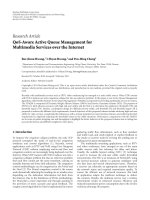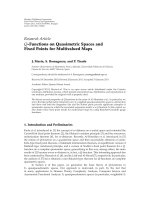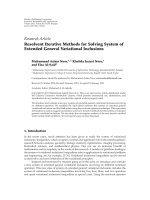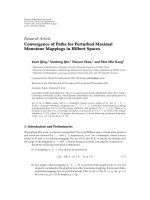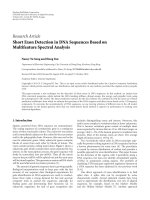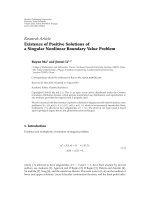Báo cáo hóa học: " Research Article WCDMA Uplink Interference Assessment from Multiple High Altitude Platform Configurations" potx
Bạn đang xem bản rút gọn của tài liệu. Xem và tải ngay bản đầy đủ của tài liệu tại đây (775.78 KB, 7 trang )
Hindawi Publishing Corporation
EURASIP Journal on Wireless Communications and Networking
Volume 2008, Article ID 182042, 7 pages
doi:10.1155/2008/182042
Research Article
WCDMA Uplink Interference Assessment from Multiple High
Altitude Platform Configurations
T. Hult,
1
D. Grace,
2
and A. Mohammed
1
1
Department of Signal Processing, Blekinge Institute of Technology, 372 25 Ronneby, Sweden
2
Department of Electronics, University of York, York, YO10 5DD, UK
Correspondence should be addressed to T. Hult,
Received 2 November 2007; Accepted 13 May 2008
Recommended by Marina Mondin
We investigate the possibility of multiple high altitude platform(HAP)coverageofacommoncellareausingawidebandcode
division multiple access (WCDMA) system. In particular, we study the uplink system performance of the system. The results show
that depending on the traffic demand and the type of service used, there is a possibility of deploying 3–6 HAPs covering the same
cell area. The results also show the effect of cell radius on performance and the position of the multiple HAP base stations which
give the worst performance.
Copyright © 2008 T. Hult et al. This is an open access article distributed under the Creative Commons Attribution License, which
permits unrestricted use, distribution, and reproduction in any medium, provided the original work is properly cited.
1. INTRODUCTION
Third-generation mobile systems are gradually being
deployed in many developed countries in hotspot areas.
However, owing to the amount of new infrastructures
required, it will still be some time before 3G is ubiquitous,
especially in developing countries. One possible cost effective
solution for deployments in these areas is to use high altitude
platforms (HAPs) [1–9] for delivering 3G (WCDMA)
communications services over a wide coverage area [10–
14]. HAPs are either airships or planes that will operate
in the stratosphere, 17–22 km above the ground. This
unique position offers a significant link budget advantage
compared with satellites and much wider coverage area than
conventional terrestrial cellular systems. Such platforms will
have a rapid rollout capability and the ability to serve a large
number of users, using considerably less communications
infrastructure than required by a terrestrial network [1]. In
order to aid the eventual deployment of HAPs, the ITU has
allocated spectrum in the 3G bands for HAPs [15], as well
as in the mm-wave bands for broadband services at around
48 GHz worldwide [16] and 31/28 GHz for certain Asian
countries [17].
Spectrum reuse is important in all wireless commu-
nications systems. Cellular solutions for HAPs have been
examined in [18, 19], specifically addressing the antenna
beam characteristics required to produce an efficient cellular
structure on the ground, and the effect of antenna sidelobe
levels on channel reuse plans [19]. HAPs will have relatively
loose station-keeping characteristics compared with satel-
lites, and the effects of platform drift on a cellular structure
and the resulting intercell handover requirements have been
investigated [20]. Cellular resource management strategies
have also been developed for HAP use [21].
Configurations of multiple HAPs can also reuse the
spectrum. They can be used to deliver contiguous coverage
and must take into account coexistence requirements [11,
12]. A technique not widely known is their ability to serve the
same coverage area reusing the spectrum to allow capacity
enhancement. Such a technique has already been examined
for TDMA/FDMA systems [22–24].Inordertoachieve
the required reduction in interference needed to permit
spectrum reuse, the highly directional user antenna is used
to spatially discriminate between the HAPs. The degree of
bandwidth reuse and resulting capacity gain is dependent on
several factors, in particular the number of platforms and the
user antenna sidelobe levels.
In the case of many 3G systems, the user antenna is
either omnidirectional or at best low gain, so in these cases
it cannot be used to achieve the same effects. The purpose
of this paper is to examine how the unique properties
of a WCDMA system can be exploited in multiple HAP
uplink architectures to deliver both coverage and capacity
enhancements (without the need for the user antenna gain).
2 EURASIP Journal on Wireless Communications and Networking
In addition to the spectral reuse benefits, there are three
main benefits for a multiple HAP architecture as follows.
(i) The configuration also provides for incremental
rollout: initially only one HAP needs to be deployed.
As more capacity is required, further HAPs can be
brought into service, with new users served by newly
deployed HAPs.
(ii) Multiple operators can be served from individual
HAPs, without the need for complicated coexistence
criteria since the individual HAPs could reuse the
same spectrum.
(iii) HAPs will be payload power, volume and weight
constrained, limiting the overall capacity delivered by
each platform. Capacity densities can be increased
with more HAPs. Moreover, it may be more cost
effective to use much lower capability HAPs [25]
(e.g., solar powered planes), rather than one big HAP
(e.g., solar powered airship), when covering a large
number of cells.
The paper is organised as follows: in Section 2 the mul-
tiple HAP scenario is explained. The interference analysis
is presented in Section 3.InSection 4, we examine the
completely overlapping coverage area case, different numbers
of platforms, and simulation results showing the achievable
capacity enhancement are presented. Finally, conclusions are
presented in Section 5.
2. MULTIPLE HAP SYSTEM SETUP
In this paper, we use a simple geometric positioning of the
high altitude platforms to create signal environments that
can easily be compared and analysed. In each constellation,
the HAPs are located with equal separation along a circular
contour, as shown in Figure 1.
The separation distance d
m
along the line from the
vertical projection of the HAP on the ground to the cell
centre is varied from 70 km to zero (i.e., all the HAPs will
be located on top of each other in the latter case).
All HAPs in this paper are assumed to be flying in the
stratosphere at an altitude of 20 km. The size of the coverage
area assigned to each HAP is governed by the shape of the
base station antenna pattern. If we assume that we only have
one cell per HAP, then the coverage area is also synonymous
with the total cell area of the HAP.
2.1. User positioning geometry
Each user equipment (UE) is positioned inside the cell
according to an independent uniform random distribution
over the cell coverage area with radius R, as shown in
Figure 2. The position of each UE inside each cell is defined
relative to the HAP base station that it is connected to and
also relative to every other HAP borne base station. This
is necessary in order to evaluate the impact of interference
between the different UE-HAP transmission paths.
HAPCOS
HAPCOS
R
θ
m
d
m
Figure 1: An example of a system simulation setup with N = 2
HAPs with overlapping cells of radius R. d
m
is the distance on the
ground between the cell centre and the vertical projection of the
HAP on the ground and θ
m
is the elevation angle towards the HAP.
BS1
BS2
BS3
Cell boundary
Figure 2: A plot showing a sample distribution of 150 UE, where
50 UEs are assigned to each of the three base stations (BS1, BS2, and
BS3).
2.2. Base station antenna pattern
The base station antenna pattern for the simulations was
chosen to be simple but detailed enough to show the effects
of the main and sidelobes, especially in the null directions,
as illustrated in Figure 3. A simple rotationally symmetric
pattern based on a Bessel function is used for this purpose,
andisdefinedby[26]
G(ϕ)
≈ 0.7·
2·J
1
70π/ϕ
3dB
) sin(ϕ
sin(ϕ)
2
,(1)
where J
1
is a Bessel function of the first kind and order 1,
ϕ
3dB
is the 3 dB beam width in degrees of the main antenna
lobe. The 3 dB beam width of the antenna is computed from
the desired cell radius according to
ϕ
3dB
= 2·atan
cellradius
HAP altitude
. (2)
2.3. User equipment antenna pattern
In this analysis, we assume that each UE employs a directive
antenna and communicates with its corresponding HAP base
T. Hult et al. 3
−70
−60
−50
−40
−30
−20
−10
0
Normalized antenna gain G (dB)
−100 −50 0 50 100
E-plane θ (degrees)
Cell radius 10 Km
Cell radius 5 Km
Cell radius 2 Km
Figure 3: HAP base station antenna patterns for different cell radii.
station. Using this assumption, we only need to set the
desired maximum gain of the UE antenna we want to use, as
shown Ta bl e 1. The antenna pattern of the directive antennas
is calculated according to (1), but with a fixed maximum gain
G
max
instead of a fixed main beamwidth, the beamwidth is
then ϕ(G
max
).
2.4. UE-HAP radio propagation channel model
In this paper, we use the combined empirical fading model
(CEFM) together with the free space loss (FSL) model.
CEFM combines the results of the empirical roadside
shadowing (ERS) model [27] for low-elevation angles with
the high-elevation angle results from [28] for the L and S
bands. Using the FSL model, the path loss from UE n to HAP
base station m is given by
l
FSL
m,n
=
4·π·d
m,n
2
G
rx
m,n
·G
tx
m,n
·λ
2
,(3)
where d
m,n
is the line of sight distance between the UE n
and HAP m.ThereceiverG
rx
m,n
and transmitter G
tx
m,n
antenna
gain patterns are calculated using (1)and(2). The carrier
frequency f
c
used in the simulation is 1.9 GHz which gives
awavelengthλ of 0.1579 meters. The CEFM fading loss
associated to HAP m is calculated as
L
f
θ
m
= a·log
e
(p)+b[dB], (4)
where p is the percentile outage probability, and the data
fitting coefficients a and b are calculated according to [27]
a
= 0.002·θ
2
m
−0.15·θ
m
−0.7 −0.2·f
c
,
b
= 27.2+1.5·f
c
−0.33·θ
m
,
(5)
where θ
m
is the elevation angle of HAP m. The total channel
Table 1: Antenna gains used in the simulation setup.
User equipment Maximum antenna gain [dBi]
Mobile phone 0
Data terminal 2, 4, 12
gain from UE n to HAP m is then given by
g
m,n
(θ
m
) =
l
FSL
m,n
·10
(L
f
(θ
m
)/10)
−1
. (6)
2.5. WCDMA setup
The different service parameters used in this paper are
collected from the 3GPP standard [29] and are summarised
in Ta bl e 2 . In order to account for the relative movement
between the UE and the base stations, a fading propagation
channel model based on (6) is simulated. This results in a
block error rate (BLER) requirement of 1% for the 12.2 kbps
voice service and a BLER of 10% for 64, 144, and 384 kbps
data packet services, respectively.
3. INTERFERENCE ANALYSIS
Assuming that we have a setup of M different HAPs covering
the same cell area and N users connected to each HAP,
we can denote each UE position as (x
m,n
, y
m,n
), where n =
{
1, 2, , N} and m ={1, 2, , M}. An example of a
scenario setup with N
= 50 and M = 3 is shown in
Figure 2. The maximum power p
tx
m,n
that the user in location
(x
m,n
, y
m,n
) is transmitting is dependent of the type of service
used and can be obtained from Tab le 2 . In WCDMA systems,
power control is a powerful and essential method exerted in
order to mitigate the near-far problem. The power received
at base station (HAP) m from user n is
p
rx
m,n
θ
m
=
p
tx
m,n
·g
m,n
θ
m
,(7)
where g
m,n
θ
m
is the total link gain, as defined in (6),
between UE transmitter n and its own cell’s BS receiver
m. To be able to maintain a specific quality of service, we
need to assert that we maintain a good enough signal-to-
interference-plus-noise ratio (SINR) level. From Ta b le 2 ,we
can see the required E
b
/N
0
values for different services, and
we can express the required SINR, γ
m,n
for user n at HAP base
station m as
γ
req
m,n
=
R
W
·
E
b
N
0
req
,(8)
where R is the data rate of the service and W is the “chip rate”
of the system. The required SINR can then be expressed as
γ
req
m,n
=
p
rx
m,n
θ
m
I
tot
=
p
tx
m,n
M
m
=1
N
n
=1
n
/
=n
p
tx
m
,n
·
g
m
,n
θ
m
/g
m,n
(θ
m
+p
w
/g
m,n
θ
m
,
m
={1, 2, , M}, n ={1, 2, , N},
(9a)
4 EURASIP Journal on Wireless Communications and Networking
Table 2: WCDMA service parameters employed in the simulation.
Parameters
Type of service
Voice Data Data Data
Chip rate, W 3.84 Mcps
Data rate, R 12 kbps 64 kbps 144 kbps 384 kbps
Required E
b
/N
0
11.9 dB 6.2 dB 5.4 dB 5.8 dB
Maximum tx Power, p
tx
m,n
125 mW (21 dBm) 125 mW (21 dBm) 125 mW (21 dBm) 250 mW (24 dBm)
Voice activity 0.67 1 1 1
which can be formulated as
γ
req
i
=
p
tx
m,n
K
k
=1
n
/
=n
p
tx
k
·
g
k
θ
m
/g
i
θ
m
+ p
w
/g
i
θ
m
,
i
= 1+(n − 1) + N(m − 1) ∈ R
K=M·N
,
m
={1, 2, , M}, n ={1, 2, , N},
(9b)
with K
= M·N as the total number of users in all cells and p
w
is the additive white Gaussian noise (AWGN) at the receiver,
where γ
req
m,n
⇒ γ
req
i
, g
m
,n
(θ
m
) ⇒ g
k
(θ
m
), g
m,n
(θ
m
) ⇒
g
i
(θ
m
), and p
tx
m
,n
(θ
m
) ⇒ p
tx
k
(θ
m
) are performed according
to the index mapping rules in (9b). To solve for the
transmitter power p
tx
k
of each of the K individual UE
simultaneously, (9b) can be reformulated into a matrix form
as
p
tx
= (I −A)
−1
b, (10)
where the calculated vector p
tx
contains the necessary
transmitter power level assigned to each of the K UE to fulfil
the SINR requirement and where matrix [A]
K×K
and vector
[b]
K×1
are defined as
a
ik
K×K
= γ
req
i
·
gk
θ
m
gi
θ
m
for n
/
=n,
a
ik
= 0forn
= n,
b
i
K×1
= γ
req
i
·
p
w
gi
θ
m
,
m
={1, 2, , M}, n ={1, 2, , N},
i
= 1+(n − 1) + N(m − 1) ∈ R
K=M·N
,
m
={1, 2, , M}, n
={1, 2, , N},
k
= 1+
n
=−1
+ N
m
−1
∈
R
K=M·N
.
(11)
Using the p
tx
= g p
tx
,where denotes an elementwise
multiplication and g is the total channel gain vector [g
k
]
K×1
for all k ={1, 2, , K} users, then all elements in the vector
p
tx
for each block that contain the UE of each of the M
cells are balanced. The total cell interference can then be
calculated as
I
own
m
θ
m
=
N
n=1
p
rx
m,n
θ
m
, m ={1, 2, ,M},
I
oth
m
θ
m
=
M
m
=1
m
/
=m
N
n=1
p
rx
m
,n
θ
m
+ p
w
, m ={1, 2, , M},
(12)
where p
w
is the thermal noise at the receiver, I
own
m
(θ
m
) is the
interference from the UE within the own cell m,andI
oth
m
(θ
m
)
is the interference from the UE in the M
− 1 other cells,
where M is the total number of cells. We can now calculate
i
UL
θ
m
which defines the other to own interference ratio for
the uplink to HAP m and is given by
i
UL
θ
m
=
I
oth
m
θ
m
I
own
m
θ
m
. (13)
This is a performance measure of the simulated system
capacity at a specific elevation angle θ
m
towards the HAP
(see Figure 1). If i
UL
θ
m
is between zero and one, there is
possibility to have multiple HAP base stations covering the
same coverage area. The actual number of users that can
access the HAP base stations is also dependent of which data
rate each user is using for transmission.
4. SIMULATION RESULTS
In this simulation, we assume that M HAPs are uniformly
located along a circular boundary, with the centre of the
circular boundary acting as the pointing direction of the
HAPs base station antennas which simulate several overlap-
ping cells; see Figure 1. The beamwidth of these base station
antennas is determined by the radius of the cell coverage area
(see Figures 1 and 2).
The aim of the simulation is to assess the effect of adding
more HAPs on the system capacity. The distance d
m
between
the cell centre and the vertical projection of the HAP on the
earth surface is denoted as “distance on the ground” and is
varied from 0 to 70 km with a fixed cell position, as shown
in Figure 4. The distance to the cell centre is also changing
the elevation angle θ
m
towards the HAP base station m as
seen from the user. The cell radius has been set to 10 km and
30 km, and the HAP altitude is 20 km. Each HAP base station
serves 100 users within each corresponding cell.
From Figure 5, it is clear that with the smaller cell radius
(10 km), the worst case scenario will occur when all the HAPs
T. Hult et al. 5
HAPCOS
R
θ
m
d
m
Figure 4: A plot illustrating the change of HAP position d
m
to create different elevation angles θ
m
.
0
0.2
0.4
0.6
0.8
1
1.2
1.4
1.6
1.8
Other to own interference ratio i
UL
0 10203040506070
Distance on the ground d
m
(Km)
2HAPs
3HAPs
4HAPs
5HAPs
(a)
0
0.2
0.4
0.6
0.8
1
1.2
1.4
1.6
Other to own interference ratio i
UL
0 10203040506070
Distance on the ground d
m
(Km)
2HAPs
3HAPs
4HAPs
5HAPs
(b)
Figure 5: The performance of the voice service (12 kbps) from one HAP in combination with the data service (384 kbps) on the remaining
HAPs for cell radius of 10 km (a) and 30 km (b). The distance on the ground d
m
is varied from 0 to 70 km.
are stacked on top of each other at 90 degrees elevation angle
from the cell centre (i.e., at a distance d
m
on the ground of
0 km). In the larger cell radius case (30 m), the worst case
scenario happens approximately at 30 km which is at the edge
of the cell.
Comparing Figure 5(b) with the two diagrams in
Figure 6, we can see that if we utilize a maximum allowed
other-to-own interference ratio equal to one, then as the
service data rate decreases, the number of possible HAP base
stations covering the same area can increase from 2–4 HAPs
(depending on the distance d
m
between the cell centre and
the vertical projection of the HAP on the ground) for the
combined service (12 kbps and 384 kbps) to 6 HAPs with
the same service (12 kbps on all HAPs). It is also clear from
Figure 6 that the worst case distance (highest interference
level) is at approximately 30 km, and consequently a worst
case elevation angle of 34 degrees. This maximum interfer-
ence level depends on the cell radius chosen for the HAP base
station as shown in Figure 7. Simulations have shown that for
cell radii larger than 10 km the maximum interference level
will occur at the cell boundary.
5. CONCLUSIONS
In this paper, we have investigated the possibility of multiple
HAP coverage of a common cell area in WCDMA systems
and in particular we have studied the uplink. From these
simulations, it is shown that as the service data rate decreases,
the number of possible HAP base stations that can be
deployed to cover the same geographical area increases. We
have also shown that the worst case position of the HAPs is in
the centre of the cell if the cell radius is small (<20 km) and at
the cell boundary for large cells (>20 km). We can conclude
that there is a possibility of deploying 3–5 HAPs covering the
same cell area in response to an increase in traffic demands,
depending on the type of service used.
6 EURASIP Journal on Wireless Communications and Networking
0.1
0.2
0.3
0.4
0.5
0.6
0.7
0.8
0.9
1
1.1
Other to own interference ratio i
UL
010203040506070
Distance on the ground d
m
(Km)
5HAPs
4HAPs
3HAPs
2HAPs
(a)
0
0.2
0.4
0.6
0.8
1
1.2
1.4
Other to own interference ratio i
UL
010203040506070
Distance on the ground d
m
(Km)
6HAPs
5HAPs
4HAPs
3HAPs
2HAPs
7HAPs
(b)
Figure 6: The other-to-own interference ratio obtained for a 30 km cell radius for (a) the performance of the voice service (12 kbps) from
one HAP in combination with the data service (144 kbps) on the remaining HAPs and (b) the performance when we have voice services
(12 kbps) on all HAPs. The distance on the ground d
m
is varied from 0 to 70 km.
0
0.1
0.2
0.3
0.4
0.5
0.6
0.7
0.8
0.9
1
Other to own interference ratio i
UL
0 1020304050607080
Distance on the ground d
m
(Km)
50 Km
30 Km
20 Km
10 Km
5Km
Figure 7: Illustrating the effect of HAP base station cell radius
on interference levels. A system of 3 HAPs is utilized here and a
voice service (12 kbps) from one HAP in combination with the data
service (384 kbps) on the other HAPs. The distance on the ground
d
m
is varied from 0 to 70 km.
ACKNOWLEDGMENTS
This work has been developed as part of a short-term
scientific mission at the University of York, UK, and
organised through COST 297 ( The
funding of the European Community and the hospitality of
University of York is greatly acknowledged.
REFERENCES
[1] R. Steele, “Guest editorial—an update on personal communi-
cations,” IEEE Communications Magazine, vol. 30, no. 12, pp.
30–31, 1992.
[2]D.Grace,N.E.Daly,T.C.Tozer,A.G.Burr,andD.A.
J. Pearce, “Providing multimedia communications services
from high altitude platforms,” International Journal of Satellite
Communications, vol. 19, no. 6, pp. 559–580, 2001.
[3] G. M. Djuknic, J. Freidenfelds, and Y. Okunev, “Establishing
wireless communications services via high-altitude aeronau-
tical platforms: a concept whose time has come?” IEEE
Communications Magazine, vol. 35, no. 9, pp. 128–135, 1997.
[4] M. J. Collela, J. N. Martin, and I. F. Akyildiz, “The HALO
network
TM
,” IEEE Communications Magazine,vol.38,no.6,
pp. 142–148, 2000.
[5] T. C. Tozer and D. Grace, “High-altitude platforms for wireless
communications,” Electronics & Communication Engineering
Journal, vol. 13, no. 3, pp. 127–137, 2001.
[6] J. Thornton, D. Grace, C. Spillard, T. Konefal, and T. C.
Tozer, “Broadband communications from a high-altitude
platform: the European HeliNet programme,” Electronics &
Communication Engineering Journal, vol. 13, no. 3, pp. 138–
144, 2001.
[7]D.Grace,M.H.Capstick,M.Mohorcic,J.Horwath,M.B.
Pallavicini, and M. Fitch, “Integrating users into the wider
broadband network via high altitude platforms,” IEEE Wireless
Communications, vol. 12, no. 5, pp. 98–105, 2005.
[8] R. Miura and M. Oodo, “Wireless communications system
using stratospheric platforms,” Journal of the Communication
Research Laboratory, vol. 48, no. 4, pp. 33–48, 2001.
[9] J M. Park, B J. Ku, Y S. Kim, and D S. Ahn, “Technol-
ogy development for wireless communications system using
stratospheric platform in Korea,” in Proceedings of the 13th
IEEE International Symposium on Personal, Indoor and Mobile
Radio Communications (PIMRC ’02), vol. 4, pp. 1577–1581,
Lisbon, Portugal, September 2002.
T. Hult et al. 7
[10] F. Dovis, R. Fantini, M. Mondin, and P. Savi, “Small-
scale fading for high-altitude platform (HAP) propagation
channels,” IEEE Journal on Selected Areas in Communications,
vol. 20, no. 3, pp. 641–647, 2002.
[11] Y. C. Foo, W. L. Lim, and R. Tafazolli, “Performance of high
altitude platform station (HAPS) in delivery of IMT-2000 W-
CDMA,” in Proceedings of the Stratospheric Platform Systems
Workshop, Tokyo, Japan, September 2000.
[12] E. Falletti, M. Mondin, F. Dovis, and D. Grace, “Integration of
a HAP within a terrestrial UMTS network: interference analy-
sis and cell dimensioning,” Wireless Personal Communications,
vol. 24, no. 2, pp. 291–325, 2003.
[13] S. Masumura and M. Nakagawa, “Joint system of terrestrial
and high altitude platform station (HAPS) cellular for W-
CDMA mobile communications,” IEICE Transactions on Com-
munications, vol. E85-B, no. 10, pp. 2051–2058, 2002.
[14] M. A. V
´
azquez-Castro, D. Belay-Zelek, and A. Curieses-
Guerrero, “Availability of systems based on satellites with
spatial diversity and HAPS,” Electronics Letters, vol. 38, no. 6,
pp. 286–288, 2002.
[15] Recommendation ITU-R M.1456, “Minimum performance
characteristics and operational conditions for high altitude
platform stations providing IMT-2000 in the bands 1885–
1980 MHz, 2010–2025 MHz and 2110–2170 MHz in the
regions 1 and 3 and 1885–1980 MHz and 2110–2160 MHz in
region 2,” International Telecommunications Union, 2000.
[16] Recommendation ITU-R F.1500, “Preferred characteristics
of systems in the fixed service using high-altitude platform
stations operating in the bands 47.2–47.5 GHz and 47.9–
48.2 GHz,” International Telecommunications Union, 2000.
[17] M. Oodo, R. Miura, T. Hori, T. Morisaki, K. Kashiki, and
M. Suzuki, “Sharing and compatibility study between fixed
service using high altitude platform stations (HAPS) and
other services in the 31/28 GHz bands,” Wireless Personal
Communications, vol. 23, no. 1, pp. 3–14, 2002.
[18] B. El-Jabu and R. Steele, “Cellular communications using
aerial platforms,” IEEE Transactions on Vehicular Technology,
vol. 50, no. 3, pp. 686–700, 2001.
[19] J. Thornton, D. Grace, M. H. Capstick, and T. C. Tozer,
“Optimizing an array of antennas for cellular coverage from
a high altitude platform,” IEEE Transactions on Wireless
Communications, vol. 2, no. 3, pp. 484–492, 2003.
[20] J. Thornton and D. Grace, “Effect of lateral displacement of a
high-altitude platform on cellular interference and handover,”
IEEE Transactions on Wireless Communications, vol. 4, no. 4,
pp. 1483–1490, 2005.
[21] D. Grace, C. Spillard, J. Thornton, and T. C. Tozer, “Channel
assignment strategies for a high altitude platform spot-beam
architecture,” in Proceedings of the 13th IEEE International
Symposium on Personal, Indoor and Mobile Radio Communi-
cations (PIMRC ’02), vol. 4, pp. 1586–1590, Lisbon, Portugal,
September 2002.
[22] D. Grace, J. Thornton, G. Chen, G. P. White, and T. C.
Tozer, “Improving the system capacity of broadband services
using multiple high-altitude platforms,” IEEE Transactions on
Wireless Communications, vol. 4, no. 2, pp. 700–709, 2005.
[23] G. Chen, D. Grace, and T. C. Tozer, “Performance of
multiple high altitude platforms using directive HAP and user
antennas,” Wireless Personal Communications,vol.32,no.3-4,
pp. 275–299, 2005.
[24] Y. Liu, D. Grace, and P. D. Mitchell, “Effective system spectral
efficiency applied to a multiple high-altitude platform system,”
IEE Proceedings: Communications, vol. 152, no. 6, pp. 855–860,
2005.
[25] D. Grace and P. Likitthanasate, “A business modelling
approach for broadband services from high altitude plat-
forms,” in Proceedings of the International Conference on
Telecommunications (ICT ’06), Madeira, Portugal, May 2006.
[26] C. A. Balanis, Antenna Theory: Analysis and Design,chapter6,
John Wiley & Sons, New York, NY, USA, 1997.
[27] J. Goldhirsch and W. J. Vogel, “Propagation eff
ects for land
mobile satellite systems: overview of experimental and model-
ing results,” NASA Reference Publication 1274, February 1992.
[28] M. A. N. Parks, G. Butt, B. G. Evans, and M. Richharia,
“Results of multiband (L, S, Ku band) propagation mea-
surements and model for high elevation angle land mobile
satellite channel,” in Proceedings of the 17th NASA Propagation
Experimenters Meeting (NAPEX 17) and the Advanced Com-
munications Technology Satellite (ACTS) Propagation Studies
Miniworkshop, pp. 193–202, Pasadena, Calif, USA, June 1993.
[29] “Base Station (BS) radio transmission and reception,” 3GPP
TS 25.104, />
